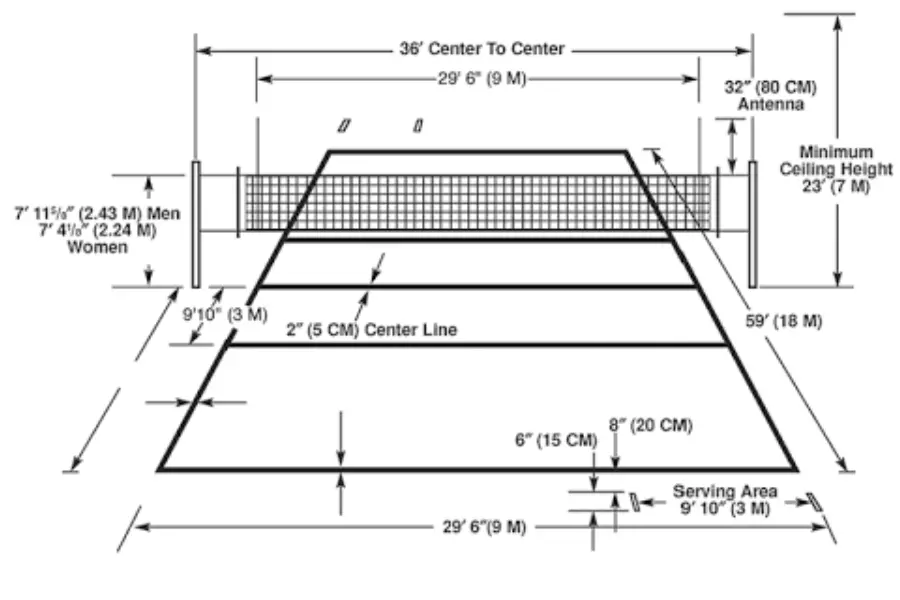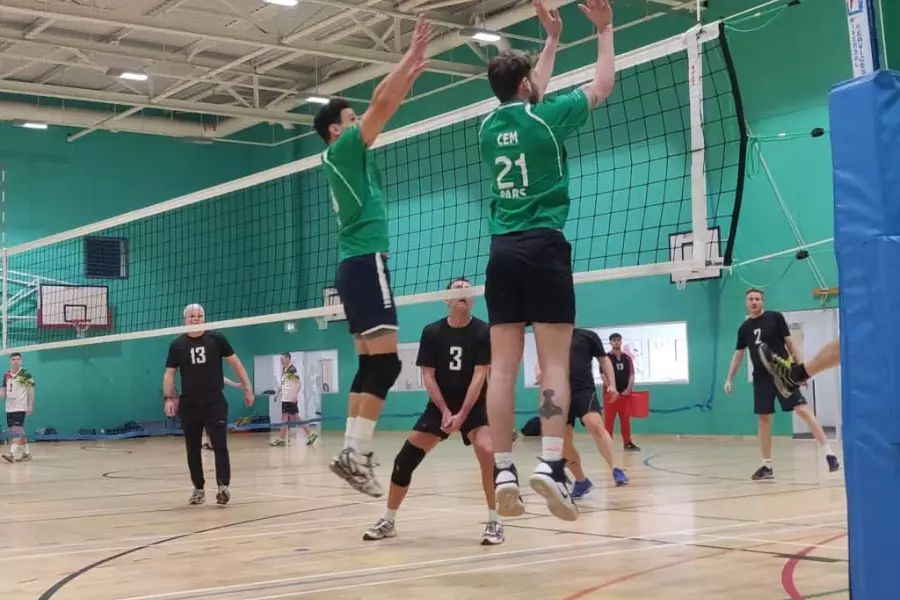A Guide to Official Regulation Volleyball Net Height for Olympic, Professional, NCAA, Recreational, High School, Middle School, and Youth Teams.
For a variety of reasons, you need to decide what volleyball net height is right for your team. Being prepared for the officials on match day means knowing accurate volleyball net heights as a coach!
Volleyball net heights vary according to age group, gender, ability, and number of players on your team. For exact net height with every set-up, a regulation net system is also necessary.
No matter if you’re coaching a professional team, Olympic team, NCAA team, high school team, middle school team, youth team, or indoor or beach volleyball team, follow these guidelines to ensure the volleyball net is at the right height for your players.
What’s The Official Net Height?

A volleyball net height of six feet six inches was originally established by William G. Morgan when he first invented the sport at the end of the 1800s.
It was introduced through the Young Men’s Christian Association, which is why the net height was lower in the beginning.
Currently, for the men, the official volleyball net height is seven (7) feet 11 5/8 inches from the top of the net to the ground, measured at the center of the court. This equals 2.43 meters if you’re using the metric system.
It is officially 7 feet four 1/4 inches in height for the women’s volleyball net, which is measured the same way. It reads 2.24 meters in meters.
From the center of the playing court, the height of the net is measured. There must be no more than two cm (3/4″) difference between the net height above the two sidelines and the official height must not be exceeded by more than two cm (3/4″).
You may enjoy reading How Tall Are Volleyball Nets
Volleyball net height regulations for indoors and outdoors

Coaches should always measure the regulation volleyball net height at the middle of the net, and the sides cannot exceed 344 inches higher than the regulation height. Co-ed volleyball uses men’s net height settings, although there is a difference between the heights of men’s and women’s volleyball nets.
The height of volleyball nets on indoor and beach courts
Men’s Volleyball Net Heights
There is no standard regulation volleyball net height for men (this applies also for standing disabled men’s volleyball teams), but teams in the 55+ age bracket can lower their nets.
- Standard Men’s Volleyball Net Height: 7 feet, 11 ⅝ inches or 2.43 meters
- Men’s Volleyball Net Height Ages 55-69: 7 feet, 9 ⅝ inches or 2.38 meters
- Men’s Volleyball Net Height Ages 70+: 7 feet, 6 inches or 2.29 meters
Women’s Volleyball Net Heights
In women’s volleyball, the official regulation volleyball net height can be lowered for certain age groups similar to that in men’s volleyball. Women’s standing volleyball teams that play disabled volleyball must follow the same height regulations as women’s regular volleyball teams.
- Standard Women’s Volleyball Net Height: 7 feet, 4 ⅛ inches or 2.24 meters
- Women’s Volleyball Net Height Ages 45+: 7 feet, 2 ⅛ inches or 2.19 meters
Sitting Volleyball Net Heights
There is a lower volleyball net installed on a sitting volleyball court than on a standard volleyball court, and sitting volleyball teams play on a smaller court. Women’s teams are required to meet international net heights of 3 feet 5.34 inches or 1.05 meters, while men’s teams are required to meet international net heights of 3 feet 9.28 inches or 1.15 meters.
Younger players’ indoor volleyball net heights
Youth Volleyball Net Heights
For youth volleyball teams, the net height is the same for both boys and girls, except for under-ten-year-old girls.
- Standard Boy’s & Girl’s Junior Volleyball Net Height Ages 11 – 12: 7 feet or 2.13 meters
- Boy’s Junior Volleyball Net Height Ages 10 and under 7 feet or 2.13 meters
- Girl’s Junior Volleyball Net Height Ages 10 and under: 6 feet, 6 inches or 1.98 meters
Middle School Volleyball Net Heights
There is a variation in volleyball net heights for players in middle school. Each state has a different governing body for measuring, so always consult yours.
What Are The Net Height Changes With The Variations of the Game?
There were a variety of variations of the game over time, including coed, and reverse-coed, as well as leagues and championships for players in their 40s, 50s, 60s, and 70s.
This variation in the game has led to the volleyball net height evolving to fit the competitiveness and physicality necessary for each variation.
Rules and Violations of Volleyball Net Regulations

In order for the ball to reach the opponent’s side, it must travel a minimum height through the net. In case the ball goes inside or under the net, that’s it-point over. There are a few more rules concerning volleyball’s net. You need to know these 3 net rules.
Touching the Net
A volleyball player who touches the net during active play will forfeit the point. Nonetheless, touching the net does not interfere with play so long as it does not interfere with the game. The role of a referee in this situation is crucial.
A situation may arise in which two players, one from each team, touch the net simultaneously. In blocking situations, this occurs most frequently. Referees, in these situations, declare the ball dead and replay the point if they cannot determine who was the first offender.
Blocking over the Net
Among volleyball’s most effective defenses is the block, and the best blockers are extremely athletic so they can generate the height needed to deflect opposition attacks.
When the ball is on its way up, blocking it with your hands over the net, to the opponent’s side, is one of the most effective methods of blocking. Regardless of the form you play, this is perfectly legal – provided you don’t touch the net with any part of your body, either while standing or jumping.
Foot under the Net
How about putting your foot under the net instead of just your arms and hands? Well, in volleyball, you can put your foot under the net, but you need to be careful not to interfere with or contact an opponent.
Additionally, if you put your foot down, some of the bottom must still make contact with the court or the center line. In such an instance, you lose the point if your foot is completely rooted in your opponent’s territory.
Beach volleyball is the only variation where you can run under the net and hit the ball back on your side of the court without needing to remain on it. Keep in mind that physically interfering with opponents is not allowed.
Beach volleyball’s more liberal rule is due in part to the small number of players: fewer short players, more room to move without interfering!
You may enjoy reading Best Volleyball Training Equipment For Home
Here are some tips for measuring a regulation volleyball net
You should keep the following things in mind when measuring your volleyball net height to prevent making any mistakes:
- Use an appropriate measuring device (net chain) when measuring the height of your net.
- Be sure to measure the height of your volleyball net to ensure that it is the same height over the sidelines as the volleyball playing surface.
- The height of the volleyball net should never exceed 34.4 inches.
- Coaches of beach volleyball should always measure their net heights at sand-raked levels.
- Make sure you measure your volleyball net height from ground level instead of the grass blades if you coach outdoor volleyball on grass.





